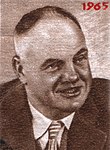Legislative elections were held in France on 2 January to elect the third National Assembly of the Fourth Republic. The elections were held using party-list proportional representation.[1][2] The elections had been scheduled for June 1956; however, they were brought forward by Edgar Faure using a constitutional sanction.[3]
| |||||||||||||||||||||||||||||||||||||||||||||||||||||||||||||||||||||||||||||||||||||
All 595 seats to the French National Assembly 298 seats were needed for a majority | |||||||||||||||||||||||||||||||||||||||||||||||||||||||||||||||||||||||||||||||||||||
|---|---|---|---|---|---|---|---|---|---|---|---|---|---|---|---|---|---|---|---|---|---|---|---|---|---|---|---|---|---|---|---|---|---|---|---|---|---|---|---|---|---|---|---|---|---|---|---|---|---|---|---|---|---|---|---|---|---|---|---|---|---|---|---|---|---|---|---|---|---|---|---|---|---|---|---|---|---|---|---|---|---|---|---|---|---|
| Turnout | 81.98% ( | ||||||||||||||||||||||||||||||||||||||||||||||||||||||||||||||||||||||||||||||||||||
| |||||||||||||||||||||||||||||||||||||||||||||||||||||||||||||||||||||||||||||||||||||
 Results by department | |||||||||||||||||||||||||||||||||||||||||||||||||||||||||||||||||||||||||||||||||||||
| |||||||||||||||||||||||||||||||||||||||||||||||||||||||||||||||||||||||||||||||||||||
The previous legislative elections in 1951 had been won by the Third Force, a coalition of center-left and center-right parties, but it was divided about denominational schools question and, when faced with the colonial problem, the governments had gradually moved towards the right. A part of the Rally of the French People (RPF), the Gaullist party, joined the majority in opposing the leadership of Charles de Gaulle, who then retired.
The defeat in the Battle of Dien Bien Phu in May 1954 caused a political crisis.[3] The Radical Pierre Mendès-France became leader of the cabinet and ended the First Indochina War. He also began the process of independence for Morocco and Tunisia, but from November 1954 on, France was confronted by the Algerian War. In February 1955, Mendès-France was replaced, at the head of the cabinet, by his rival in the Radical Party, Edgar Faure. This one led a more repressive policy in Algeria.
The far-right, led by Pierre Poujade, re-appeared at about the same time. He was a critic of "fiscalism", and leader of a shopkeepers and craftsmen's movement. Many voters seemed tired of the political system's numerous ministerial crises, and he had much support in the rural areas, which were in decline.
The anticipated legislative elections took place when Faure was defeated by the National Assembly. Even though the French Communist Party re-emerged as the country's most popular party (for the last time in its history), it did not join the government. A coalition was formed behind Mendès-France and advocated a peaceful resolution of the Algerian conflict. This Republican Front was composed of the French Section of the Workers' International (SFIO, socialist party) of Guy Mollet, the Radical Party of Pierre Mendès-France, the Democratic and Socialist Union of the Resistance of François Mitterrand and the National Centre of Social Republicans of Jacques Chaban-Delmas. Faure was excluded from the Radical Party – in response he transformed the Rally of the Republican Lefts (which had been abandoned by those groups which had now joined the Republican Front) into a party that he led, and he campaigned with the center-right parties. The French Communist Party remained the largest party and the Republican Front obtained a relative majority in order to end the Algerian War.
The Poujadists won 52 seats versus predictions of six to eight, including a young Jean-Marie Le Pen,[4] and the press stated that they held the balance of power. Media reception was mixed, with the result welcomed by communist supporters and condemned by papers such as The Times, Le Figaro,[5] and The Saturday Evening Post.[4]
The coalition cabinet was led by the Socialist leader Guy Mollet.[3] At the beginning he was also supported by the Communists, but pressure from the pieds-noir in Algeria incited him into leading a very repressive policy against the Algerian nationalists. This policy was criticized by Vice-Prime Minister Mendès-France and other members of the cabinet, who resigned, splitting the Republican Front. Mollet and his successors floundered in the conflict until May 1958.
Results
edit| Party | Votes | % | Seats | |
|---|---|---|---|---|
| French Communist Party | 5,514,403 | 25.89 | 147 | |
| Moderates | 3,259,782 | 15.30 | 95 | |
| French Section of the Workers' International | 3,247,431 | 15.25 | 88 | |
| Union for the Defense of Tradesmen and Artisans | 2,483,813 | 11.66 | 51 | |
| Republican Front (Radical Party–UDSR) | 2,389,163 | 11.22 | 73 | |
| Radical Party–RGR–UDSR (non-Front) | 838,231 | 3.94 | ||
| Popular Republican Movement | 2,366,321 | 11.11 | 71 | |
| National Centre of Social Republicans (non-Front) | 585,764 | 2.75 | 16 | |
| National Centre of Social Republicans | 256,587 | 1.20 | ||
| Far-right | 260,749 | 1.22 | 0 | |
| Miscellaneous | 98,600 | 0.46 | 3 | |
| Total | 21,300,844 | 100.00 | 544 | |
| Valid votes | 21,300,844 | 97.05 | ||
| Invalid/blank votes | 647,160 | 2.95 | ||
| Total votes | 21,948,004 | 100.00 | ||
| Registered voters/turnout | 26,772,255 | 81.98 | ||
| Source: Mackie & Rose,[6] Becker | ||||
References
edit- ^ Williams, Philip M. (1970). French Politicians and Elections 1951-1969. CUP Archive. p. 63. ISBN 9780521096089.
French election 1956.
- ^ Goguel, François (1956). "Les élections françaises du 2 janvier 1956". Revue française de science politique. 6 (1): 5–17. doi:10.3406/rfsp.1956.402673. ISSN 0035-2950.
- ^ a b c Shields, James (2007). The Extreme Right in France: From Pétain to Le Pen. Routledge. ISBN 9781134861118.
- ^ a b "France Needs Some Drastic Political Surgery". The Saturday Evening Post (editorial). 11 February 1956. p. 10. Retrieved 24 March 2020.
- ^ "Shade of Hitler Seen in French Election Vote". The Canberra Times (ACT : 1926–1995). AAP/Reuters. 5 January 1956. Retrieved 20 April 2014.
- ^ Thomas T. Mackie & Richard Rose (1982) The International Almanac of Electoral History, Macmillan, pp132–134




